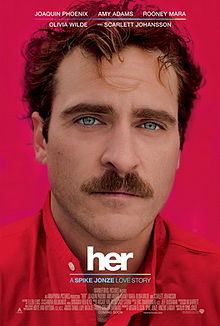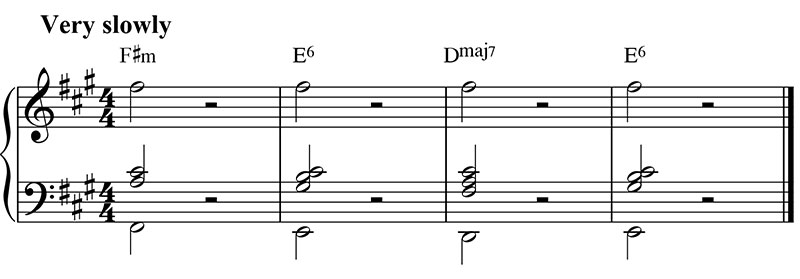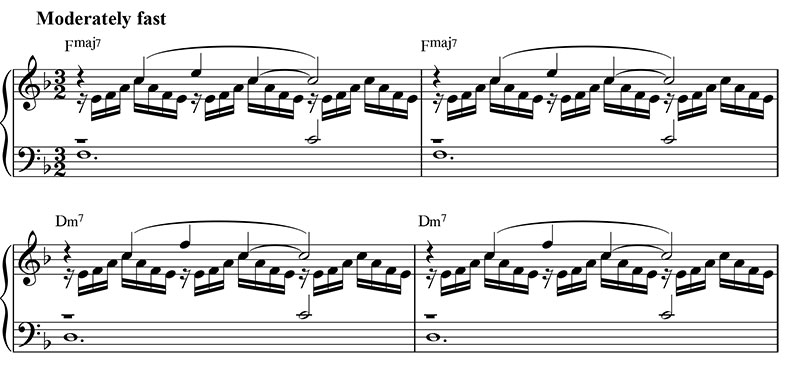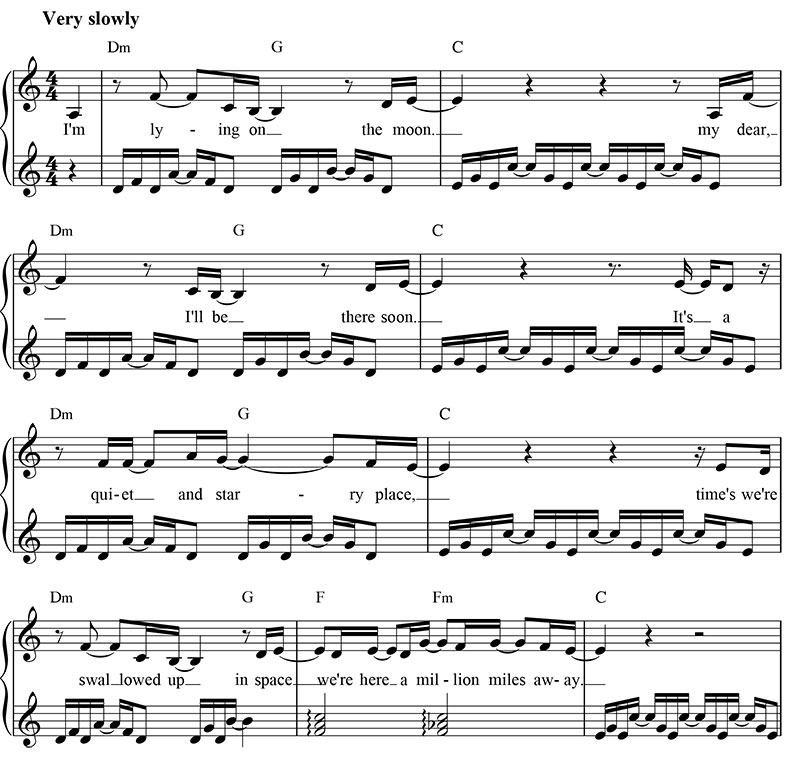
Although William Butler of the Canadian indie rock band Arcade Fire and Canadian composer/performer Owen Pallett received their first Oscar nomination for their score to the sci-fi romance film Her, this is not their first experience in film scoring. Both Arcade Fire and Pallett created the score for the 2009 film The Box, and the former contributed a song to the enormously popular film The Hunger Games. In addition, Arcade Fire is a regular collaborator with Spike Jonze, director of Her, scoring his short film Scenes from the Suburbs and the trailer for his 2009 film Where the Wild Things Are.
One of the most striking features of Butler and Pallett’s approach to film scoring in Her is its near complete lack of themes in the traditional sense, much of the score being instead devoted to chords that remain static or change very slowly. The result is a score that is based more on creating an overall mood for a scene, one of three basic methods of composing film music, as explained by Fred Karlin and Rayburn Wright in On the Track:
You can play through a scene (or a series of scenes), establishing a mood that will ignore specific moments of greater or lesser intensity. You can phrase a scene, carefully acknowledging both obvious and subtle shifts in emotional tone an dramatic content. And you can hit the action, accenting specific moments in the drama with the music. All three of these techniques and their variations may be used in a score, depending on the film’s style and dramatic requirements and the tastes of the composer and director.
Certainly, this technique of “playing through” a scene is extremely common in films that use rock and pop music, but usually this kind of music contains sung words, which not only lend meaning to the scene but must also be carefully placed during montages or longer shots so as to avoid overlapping with dialogue. In the case of Her, however, there are only a few true songs, one of them being “The Moon Song”, which was written and performed by Karen O of the rock band, Yeah Yeah Yeahs, and which received its own Oscar nomination for Best Original Song.
Another notable aspect of the score’s use in the film is its blurring of the boundary between music that is diegetic and non-diegetic, that is, the difference between what is “inside” the film that the characters can hear, and “outside” the film that the characters cannot hear. The following film music analysis will explore both the score’s playing through of the drama and its diegetic/non-diegetic blurring in several scenes.
“Loneliness”
Her tells the story of the romance between Theodore Twombly (Joaquin Pheonix), a man who is paid to write emotionally touching letters for other people, and Samantha (voiced by Scarlett Johansson), the artificially intelligent computer operating system (OS) with whom he falls in love. One of the first cues we hear is brooding, moody, and played non-diegetically. Listen to the first 45 seconds below:

This cue begins as Theodore speaks seemingly heartfelt words in a close-up shot. To whom he is speaking is not yet clear, but soon enough it is revealed that he is writing one of his letters for a client. The emotional disconnect between Theodore’s words and his own feelings of emptiness is clarified by the music’s use of an ostinato that is set in a slow tempo and minor key, all of which suggests a dull inner pain that repeatedly ebbs and flows. As the camera pans across the room, we see that Theodore is one of many employees writing emotional letters for others, not only emphasizing Theodore’s loneliness, but also raising the film’s central question of how we relate to one another emotionally and physically in a society that is becoming increasingly based on technology.
This slowly-throbbing cue returns in two other scenes: when we first see Theodore recalling happy memories with his soon-to-be ex-wife Catherine, and over a soundless montage of him going through an entire day, talking passionately with Samantha, then completely disinterested while a co-worker talks with him, and finally looking pensive while back at home. In all three scenes in which this cue appears, there is an emotional distance between Theodore and the physical people around him, even those he is only remembering. The cue, which is titled “Loneliness”, makes it clear that this distance is a source of pain for Theodore.
“Song on the Beach”
Music plays a key role in Theodore and Samantha’s relationship. The first time they make a connection through music occurs at their day on the beach, when Samantha plays Theodore a piece she wrote to express how it feels to be there with him. Listen to the first 45 seconds of it below:

Obviously, the very relaxed tempo, major key, soft jazz chords, and solo piano orchestration lend the scene a tranquility and intimacy that capture the couple’s contented love. But more subtly, we continue to hear the piece through a leap forward in time, when Theodore is travelling home by train and conversing with Samantha about his marriage. During this scene, the focus is on Theodore’s emotional bond with Samantha as he discusses matters that are close to his heart—memories of his marriage to Catherine. He also reflects on these memories visually, as we gather through a soundless montage that is shown as he talks and the music plays. “Song on the Beach” has therefore shifted from being diegetic music that Samantha uses to describe her feelings for Theodore, to non-diegetic music that now describes Theodore’s closeness to Samantha. The use of the same music in both situations suggests that the two characters are ideally suited to one another on a purely emotional level.
The “Musical Photograph”
As the film progresses, however, some of the problems of getting emotionally involved with an artificially intelligent OS begin to emerge. Samantha, for instance, is constantly aware that she lacks a physical corporeal presence. At one point, she composes another piece of music intended to act as a “musical photograph” of herself and Theodore together:

Clearly, this cue expresses the same strong emotional bond between the two as “Song on the Beach”, as it is set in the very same major key and contains the same solo piano orchestration and nearly the same progression of jazz chords, but it does so in a more effervescent way through its faster rhythms. Even notice that from 0:42, the melody from the beach cue returns, and at 1:36, the same melody returns in its original slow setting, all of which confirms the similar meaning of this new cue.
Yet at the same time, the whole raison d’être for this cue is to try to compensate for a deficiency Samantha senses in the relationship. And similar to the beach cue, the music moves from being strictly diegetic to accompanying what we understand to be Theodore’s happy memories of the two together in a non-diegetic manner, even though the sense of the music as diegetic is not lost. This use of the music once again emphasizes the couple’s strong emotional bond. Hence it becomes more poignant than “Song on the Beach” in that it points up the fact that, despite having a very close emotional connection, what the couple does not have is a physical presence together.
“The Moon Song”
This song plays an important part in our understanding of Theodore and Samantha’s developing relationship through music. The pair collaborate, for example, in the song’s composition, Theodore creating and playing the accompaniment, then asking Samantha to make up the words (and implicitly, the melody as well). They also sing together in duet-like fashion at the end of each verse. Then there are the lyrics themselves:
I’m lying on the moon,
My dear, I’ll be there soon.
It’s a quiet and starry place,
Time’s we’re swallowed up
In space we’re here a million miles away.There’s things I wish I knew
There’s no thing I keep from you.
It’s a dark and shiny place,
But with you my dear
I’m safe and we’re a million miles away.We’re lying on the moon
It’s a perfect afternoon
Your shadow follows me all day
Making sure that I’m okay and
We’re a million miles away
As the song is sung, we are shown another silent montage of what is presumed to be Theodore’s recent and happy memories with Samantha, once again adding a non-diegetic element to the music’s diegetic beginning and drawing attention to the purely emotional basis of the relationship. At this point in the story, however, more problems have begun to arise in the relationship. Samantha’s desire to have a physical body led her to invite a consenting young woman to act as her sexual “surrogate”, a situation that ended disastrously for the couple.
Samantha has also admitted she is beginning to develop more rapidly now and has sought out other OSes for help and advice. Of course in the end, her relationship with Theodore cannot last, the implication being that close human relationships always involve a physical element that cannot be denied, ignored, or replaced by technology (no matter how intelligent that technology may be). The Moon Song therefore seems to suggest that music is an ideal, though unsustainable, state in which Theodore and Samantha can coexist without a physical form. This idea is reinforced by the lyrics’ implied isolation of the two, who are together yet far from the earthly real world, “lying on the moon” and “a million miles away”.
Below is the score and the scene in which the couple sings the song:

Conclusion
Although there is relatively little repetition of musical material in the sense of traditional themes, the score for Her is nevertheless a highly effective one that captures an appropriate mood for an entire scene by “playing through” the drama, as is typical of pop/rock scores. More importantly, several of the film’s scenes place music at the forefront of Theodore and Samantha’s relationship, emphasizing their lack of a physical connection despite their emotional bond. Thus, the score highlights, and indeed gives an answer to, the film’s central question of how we relate to one another in an age that is increasingly reliant on “smart” technology.
Coming soon… Steven Price’s Gravity.
Very much enjoyed this analysis!! I haven’t seen the film but its premise seems a little far-fetched for me to be able to suspend disbelief. I’ll see it, though, because of Phoenix. He is THE great American actor, IMO, now that Phil Hoffman has died. Your analysis will make my viewing of the film richer. Thanks!
Hi Sue. I very much enjoyed Phoenix’s performance in this. It wasn’t just good, or great, but stellar. In every scene, his acting was absolutely spot on, and it’s one of the reasons why the film works well despite it’s (at least seemingly) far-fetched premise.